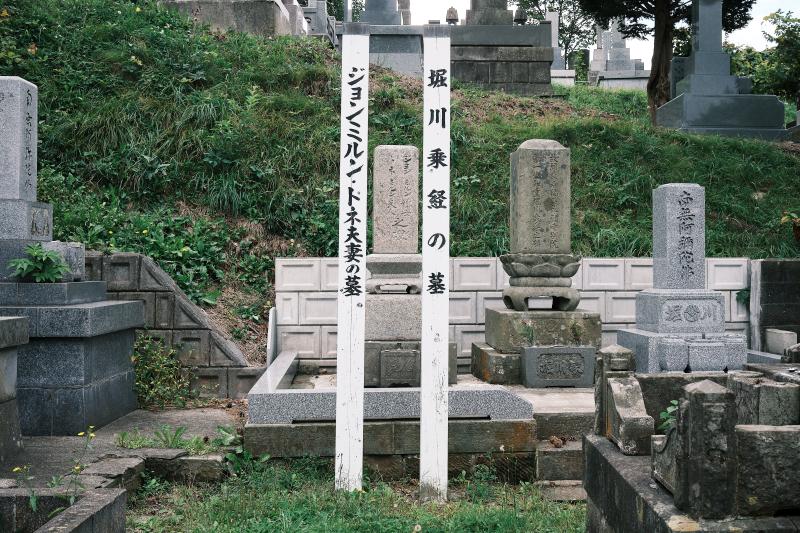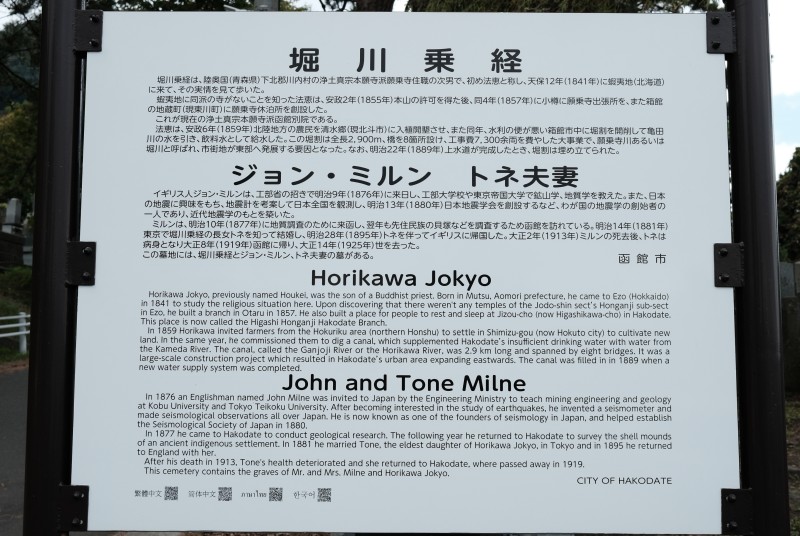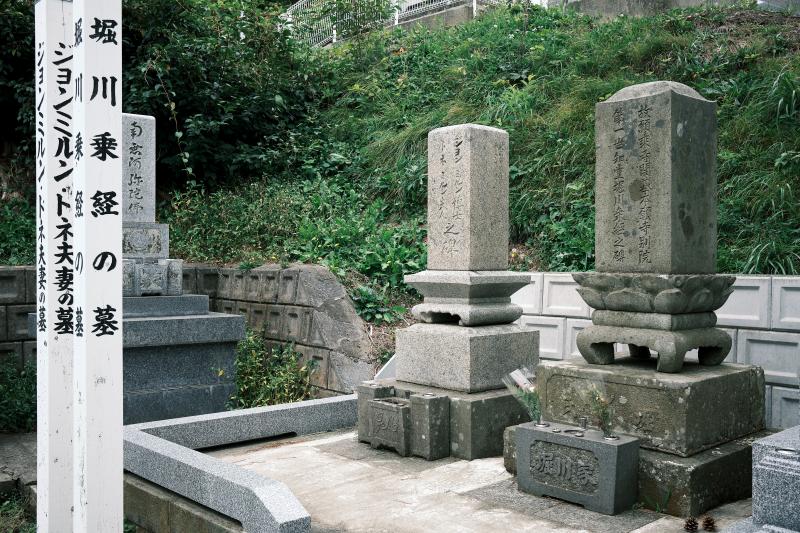函館山西側、船見町の本願寺函館別院墓地に、亀田川掘削を行い函館市街地発展に大きく貢献した堀川乗経及び日本地震学の礎を築いたジョン・ミルンとその妻で堀川乗経の娘トネの墓碑がある。


堀川乗経
堀川乗経は、陸奥国(青森県)下北郡川内村の浄土真宗本願寺派願乗寺住職の次男で、初め法恵と称し、天保12年(1841年)に蝦夷地(北海道) に来て、その実情を見て歩いた。
蝦夷地に同派の寺がないことを知った法恵は、安政2年(1855年)本山の許可を得た後、同4年(1857年)に小樽に願乗寺出張所を、また箱館の地蔵町(現東川町)に願乗寺休泊所を創設した。
これが現在の浄土真宗本願寺派函館別院である。
法恵は、安政6年(1859年)北陸地方の農民を清水郷(現北斗市)に入植開墾させ、また同年、水利の便が悪い箱館市中に堀割を開削して亀田川の水を引き、飲料水として給水した。この堀割は全長2,900m、橋を8箇所設け、工事費7,300余両を費やした大事業で、願乗寺川あるいは堀川と呼ばれ、市街地が東部へ発展する要因となった。なお、明治22年(1889年)上水道が完成したとき、堀割は埋め立てられた。ジョン・ミルン トネ夫妻
函館市
イギリス人ジョン・ミルンは、工部省の招きで明治9年(1876年)に来日し、工部大学校や東京帝国大学で鉱山学、地質学を教えた。また、日本の地震に興味をもち、地震計を考案して日本全国を観測し、明治13年(1880年)日本地震学会を創設するなど、わが国の地震学の創始者の一人であり、近代地震学のもとを築いた。
ミルンは、明治10年(1877年)に地質調査のために来函し、翌年も先住民族の貝塚などを調査するため函館を訪れている。明治14年(1881年)東京で堀川乗経の長女トネを知って結婚し、明治28年(1895年)トネを伴ってイギリスに帰国した。大正2年(1913年)ミルンの死去後、トネは病身となり大正8年(1919年)函館に帰り、大正14年(1925年)世を去った。
この墓地には、堀川乗経とジョン・ミルン、トネ夫妻の墓がある。
Horikawa Jokyo
Horikawa Jokyo, previously named Houkei, was the son of a Buddhist priest. Born in Mutsu, Aomori prefecture, he came to Ezo (Hokkaido) in 1841 to study the religious situation here. Upon discovering that there weren’t any temples of the Jodo-shin sect’s Honganji sub-sect in Ezo, he built a branch in Otaru in 1857. He also built a place for people to rest and sleep at Jizou-cho (now Higashikawa-cho) in Hakodate. This place is now called the Higashi Honganji Hakodate Branch.
In 1859 Horikawa invited farmers from the Hokuriku area (northern Honshu) to settle in Shimizu-gou (now Hokuto city) to cultivate new land. In the same year, he commissioned them to dig a canal, which supplemented Hakodate’s insufficient drinking water with water from the Kameda River. The canal, called the Ganjoji River or the Horikawa River, was 2.9 km long and spanned by eight bridges. It was a large-scale construction project which resulted in Hakodate’s urban area expanding eastwards. The canal was filled in in 1889 when a new water supply system was completed.John and Tone Milne
CITY OF HAKODATE
In 1876 an Englishman named John Milne was invited to Japan by the Engineering Ministry to teach mining engineering and geology at Kobu University and Tokyo Teikoku University. After becoming interested in the study of earthquakes, he invented a seismometer and made seismological observations all over Japan. He is now known as one of the founders of seismology in Japan, and helped establish the Seismological Society of Japan in 1880.
In 1877 he came to Hakodate to conduct geological research. The following year he returned to Hakodate to survey the shell mounds of an ancient indigenous settlement. In 1881 he married Tone, the eldest daughter of Horikawa Jokyo, in Tokyo and in 1895 he returned to England with her.
After his death in 1913, Tone’s health deteriorated and she returned to Hakodate, where passed away in 1919.
This cemetery contains the graves of Mr. and Mrs. Milne and Horikawa Jokyo.
参考
- 「堀川 乗経 (ほりかわ じょうきょう) 1824年~1878年」、 公益財団法人函館市文化・スポーツ振興財団、閲覧日2021年9月19日
- 「堀川乗経の活躍 P698」、函館市史デジタル版、閲覧日2021年9月19日
- 「願乗寺川の開削」、函館市史デジタル版、閲覧日2021年9月20日
- 「本願寺函館別院の歴史」、浄土真宗本願寺派本願寺函館別院、閲覧日2021年9月19日
- 「ジョン・ミルン 1850年~1913年」、公益財団法人函館市文化・スポーツ振興財団、閲覧日2021年9月20日
- 「ジョン・ミルン (John Milne イギリス 1850-1913)」、東京大学附属図書館、閲覧日2021年9月20日
- 「ジョン・ミルン P144-146」、函館市史デジタル版、閲覧日2021年9月20日
- 「堀川 トネ (ほりかわ とね) 1860年~1925年」、公益財団法人函館市文化・スポーツ振興財団、閲覧日2021年9月20日




コメント